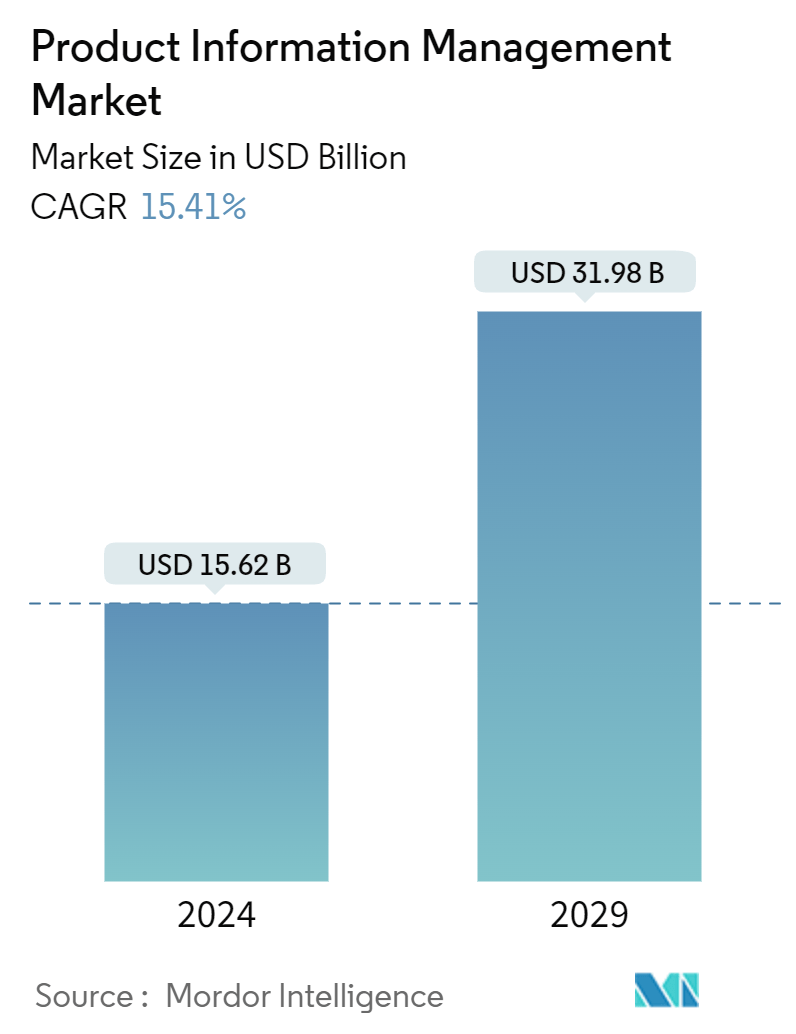Market Size of Product Information Management Industry

| Study Period | 2019 - 2029 |
| Market Size (2024) | USD 15.62 Billion |
| Market Size (2029) | USD 31.98 Billion |
| CAGR (2024 - 2029) | 15.41 % |
| Fastest Growing Market | Asia Pacific |
| Largest Market | North America |
Major Players
*Disclaimer: Major Players sorted in no particular order |
Product Information Management Market Analysis
The Product Information Management Market size is estimated at USD 15.62 billion in 2024, and is expected to reach USD 31.98 billion by 2029, growing at a CAGR of 15.41% during the forecast period (2024-2029).
Product information management (PIM) solutions unify and manage a business' product information to secure a single accurate view of product data. PIM offers a centralized platform to manage data on a business's products and services cost-effectively.
- The management of products in a central space increases the use of solutions by retailers, manufacturers, and wholesalers. PIM contributes to maintaining the consistency and quality of product data obtained from a variety of sources and consolidating them into one common database. By streamlining internal and external marketing processes, the growing adoption of PIM software in various vertical industries delivers improved customer satisfaction and omnichannel experiences.
- With the massive growth in data generation, data and information have become the backbone of organizations and businesses. In addition to storing and transferring product data, PIMs bolster overall data quality, encourage data audits, and can improve the accuracy of the product information. Data quality and consistency are naturally improved by reducing the need to manage redundant information in multiple systems. Government regulations are instrumental in augmenting the PIM market, particularly across healthcare and online business solutions, owing to the need for a centralized system to hold the data and processes and manage the launch and update of products.
- With the impact of the COVID-19 pandemic, e-commerce has significantly grown, indicating growth and adoption of PIM solutions. A continuously growing number of internet sales generates huge demand for adopting an eCommerce system. This e-commerce system offers Enterprise Resource Planning systems, Supply Chain Management Systems, and Customer Relationship Management Systems to meet customers' growing demand for real-time product information. Companies with a wide range of products have sophisticated categorizations in their product catalogs.
- This complex nature of digital commerce engages many companies to streamline product information creation, maintenance, and publication to downstream channels. PIM makes it easy for many channels and media to disseminate information. Thus, various end users are adopting this software to manage a large amount of product content. Therefore, the demand for PIM software has shown a considerable rise because of the growing complexity of data management resulting from electronic commerce.
- Data breaches have the potential to undermine the trust and reputation of businesses, resulting in diminished customer confidence and loyalty. Consequently, organizations might be hesitant to adopt new systems like PIM if they perceive them as potential data security and privacy threats. This reluctance could be particularly pronounced in industries where consumer trust is paramount, such as healthcare or finance.
- However, while the rise in data breaches may not directly restrain the PIM market, it does introduce challenges and considerations for businesses contemplating the adoption of PIM solutions. It is crucial to address data security and privacy concerns to cultivate trust, ensure compliance, and promote the adoption of PIM systems in the contemporary data-driven business landscape.
Product Information Management Industry Segmentation
The product information management market is defined based on the revenues generated from the solutions that are being used in various areas across the globe. The market also covers the major factors impacting the growth of the market in terms of drivers and restraints. Further, for the purpose of market estimation and forecasts, various factors have been taken into consideration, including use cases/applications of PIM-integrated technologies. Moreover, the report also analyses the trends/developments related to PIM solutions that are available.
The product information management market is segmented by deployment type (on-premise, cloud), offering (solution, services), end-user industry (retail, BFSI, media and entertainment, energy and utilities, healthcare, IT and telecommunication, transportation and logistics, and other end-user industries), and geography (North America, Europe, Asia-Pacific, Latin America, Middle East and Africa). The market sizes and forecasts are provided in terms of value (USD) for all the above segments.
| By Deployment | |
| Cloud | |
| On-premise |
| By Offering | |
| Solution | |
| Services |
| By End-user Industry | |
| BFSI | |
| Media and Entertainment | |
| Retail | |
| Energy and Utilities | |
| Healthcare | |
| IT and Telecommunications | |
| Transportation and Logistics | |
| Other End-user Industries |
| By Geography*** | |
| North America | |
| Europe | |
| Asia | |
| Australia and New Zealand | |
| Latin America | |
| Middle East and Africa |
Product Information Management Market Size Summary
The Product Information Management (PIM) market is poised for significant growth, driven by the increasing need for businesses to manage and unify product data across various channels. PIM solutions provide a centralized platform that enhances data quality and consistency, which is crucial for retailers, manufacturers, and wholesalers. The rise of e-commerce and digital transformation has amplified the demand for PIM systems, as businesses seek to streamline product information management to improve customer experiences and support omnichannel strategies. The market is further bolstered by regulatory requirements in sectors like healthcare and finance, which necessitate centralized data management systems. Despite concerns over data security and privacy, the adoption of PIM solutions is expected to rise, particularly in industries where maintaining consumer trust is essential.
The Asia-Pacific region is anticipated to experience the highest growth in the PIM market, fueled by the expansion of e-commerce and the adoption of cloud and data management technologies. Countries like China and India are at the forefront of this growth, driven by increasing internet penetration, smartphone usage, and a shift towards online shopping. The competitive landscape of the PIM market is fragmented, with several global and regional players vying for market share. Recent developments, such as collaborations and new product launches, indicate a dynamic market environment where companies are continuously innovating to enhance their offerings. As businesses increasingly recognize the value of effective product information management, the PIM market is set to expand, offering substantial opportunities for both established players and new entrants.
Product Information Management Market Size - Table of Contents
-
1. MARKET INSIGHTS
-
1.1 Market Overview
-
1.2 Industry Attractiveness - Porter's Five Forces Analysis
-
1.2.1 Bargaining Power of Suppliers
-
1.2.2 Bargaining Power of Buyers
-
1.2.3 Threat of New Entrants
-
1.2.4 Threat of Substitutes
-
1.2.5 Degree of Competition
-
-
1.3 Assessment of the Impact of the COVID-19 Pandemic on the Product Information Management Market
-
-
2. MARKET SEGMENTATION
-
2.1 By Deployment
-
2.1.1 Cloud
-
2.1.2 On-premise
-
-
2.2 By Offering
-
2.2.1 Solution
-
2.2.2 Services
-
-
2.3 By End-user Industry
-
2.3.1 BFSI
-
2.3.2 Media and Entertainment
-
2.3.3 Retail
-
2.3.4 Energy and Utilities
-
2.3.5 Healthcare
-
2.3.6 IT and Telecommunications
-
2.3.7 Transportation and Logistics
-
2.3.8 Other End-user Industries
-
-
2.4 By Geography***
-
2.4.1 North America
-
2.4.2 Europe
-
2.4.3 Asia
-
2.4.4 Australia and New Zealand
-
2.4.5 Latin America
-
2.4.6 Middle East and Africa
-
-
Product Information Management Market Size FAQs
How big is the Product Information Management Market?
The Product Information Management Market size is expected to reach USD 15.62 billion in 2024 and grow at a CAGR of 15.41% to reach USD 31.98 billion by 2029.
What is the current Product Information Management Market size?
In 2024, the Product Information Management Market size is expected to reach USD 15.62 billion.

